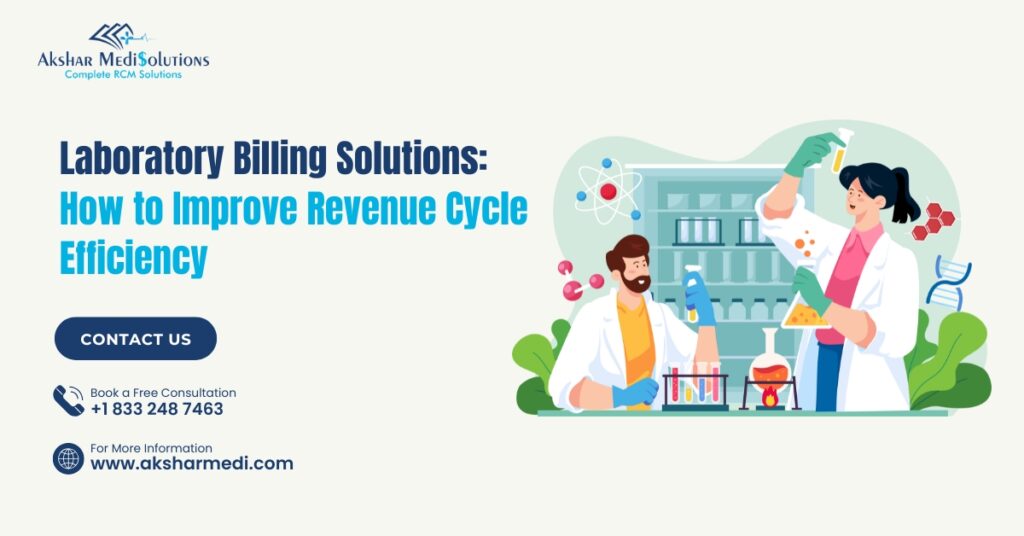At first glance, a lab’s billing process looks simple: a test is ordered, performed, and paid for. Easy, right? But if you’ve ever managed a clinical lab, you know it’s anything but. The truth is, the billing cycle can stretch from days to months — filled with data errors, denied claims, and constant back-and-forth with payers.
This silent revenue drain, often called lab revenue leakage, doesn’t always show up immediately. But over time, it eats into profitability, causes cash flow bottlenecks, and frustrates both staff and patients. The good news? With the right laboratory billing solutions, you can stop the leaks, streamline workflows, and turn your revenue cycle into a smooth, predictable engine for growth.
Understanding the Laboratory Revenue Cycle
Every dollar your lab earns flows through one system — your Revenue Cycle Management (RCM) process. It begins when a physician orders a test and ends only when you’re fully reimbursed for it.
A healthy lab RCM system includes:
Accurate Patient Registration – Clean data in means clean claims out.
Insurance Verification – Confirming coverage before the first test is processed.
Test Coding and Billing – Applying precise CPT and ICD codes for every service.
Claims Submission – Sending clean claims that won’t bounce back.
Payment Posting and Reconciliation – Matching payer payments with billed services.
Denial Management – Fixing and resubmitting claims without losing time.
Patient Collections – Collecting balances respectfully and efficiently.
If any step in this chain breaks, your revenue suffers.
Why Labs Lose Revenue (and Don’t Notice It Right Away)
You don’t need fewer patients — you need fewer errors. Labs typically lose money because of small, fixable inefficiencies:
High Denial Rates – Often caused by incomplete data or missing pre-authorizations.
Manual Billing Workflows – Human error from retyping or missed claims can be costly.
Uncollected Balances – High-deductible plans leave more responsibility on patients.
Slow Cash Flow – Late claim submissions and delayed payer responses stall revenue.
The average cost to fix a denied claim can be over 10x what it costs to file it correctly the first time. So prevention isn’t just smarter — it’s more profitable.
How Laboratory Billing Solutions Fix the Problem
Modern lab billing platforms combine automation, compliance, and analytics to address the exact weak spots that cause revenue leakage.
1. Automated Claims Processing
Automation ensures every claim is checked for accuracy before submission. Built-in claim scrubbers flag coding or modifier errors, cutting down denials dramatically. This means less rework, faster payments, and fewer headaches for your billing team.
2. Real-Time Insurance Verification
Advanced systems verify patient eligibility instantly — before the test even begins. No more sending claims to the wrong payer or discovering coverage issues after the fact.
3. Denial Management Made Easy
Even with automation, denials happen. Smart billing tools help labs track, analyze, and resubmit denied claims quickly — complete with built-in workflows for root-cause analysis and appeal templates.
4. Compliance and Security Built In
Healthcare regulations can be intimidating, but modern billing systems simplify it. With encryption, audit trails, and automatic HIPAA safeguards, you can rest easy knowing patient data is protected — and penalties are avoided.
5. Actionable Analytics
You can’t fix what you can’t measure. Integrated reporting dashboards show key KPIs like denial rates, average reimbursement time, and days in AR. Labs using this data make proactive adjustments that boost cash flow and performance.
6. Seamless EHR and LIS Integration
No more silos. When billing connects with your EHR or LIS, your workflow becomes one continuous, error-free process — from test ordering to reimbursement.
The Real Cost of Revenue Leakage
When revenue quietly slips away, it affects more than just your balance sheet. Denials and delays strain staff, slow down cash flow, and limit your ability to reinvest in new technology or expand services. A few uncollected balances may seem small — but multiplied across hundreds of tests, they become six-figure problems.
Practical Steps to Strengthen Your Lab’s Revenue Cycle
Run a billing process audit every quarter.
Identify your top three denial reasons.
Automate wherever manual data entry still exists.
Verify insurance coverage before performing tests.
Train billing staff on lab-specific coding changes.
And if your current billing system feels outdated or generic, it’s probably holding your lab back. Specialized solutions designed for laboratories — like those offered by Akshar MediSolutions — are built to handle the complexity of lab billing with precision, speed, and compliance.
Final Takeaway
Lab billing doesn’t have to be a bottleneck. With automation, compliance, and expert guidance, your lab can improve accuracy, speed up reimbursements, and finally stop losing revenue to preventable errors.
At Akshar MediSolutions, we help labs across the U.S. — especially those seeking reliable Medical Billing Services in New Jersey — streamline their revenue cycles through smart, customized billing solutions. Because when your billing runs right, your lab can focus on what really matters: accurate testing and better patient care.
FAQs About laboratory billing
It’s the end-to-end process of managing a lab’s financial workflow — from patient registration to collections and final reimbursement.
Mostly from claim denials, delayed payments, manual errors, and uncollected patient balances.
By automating claims, verifying insurance in real time, reducing denials, and providing actionable performance analytics.
Not entirely, but it can cut them down drastically by ensuring every claim is scrubbed and validated before submission.
Because we combine technology with expertise — offering tailored laboratory billing solutions that boost accuracy, compliance, and cash flow efficiency.

